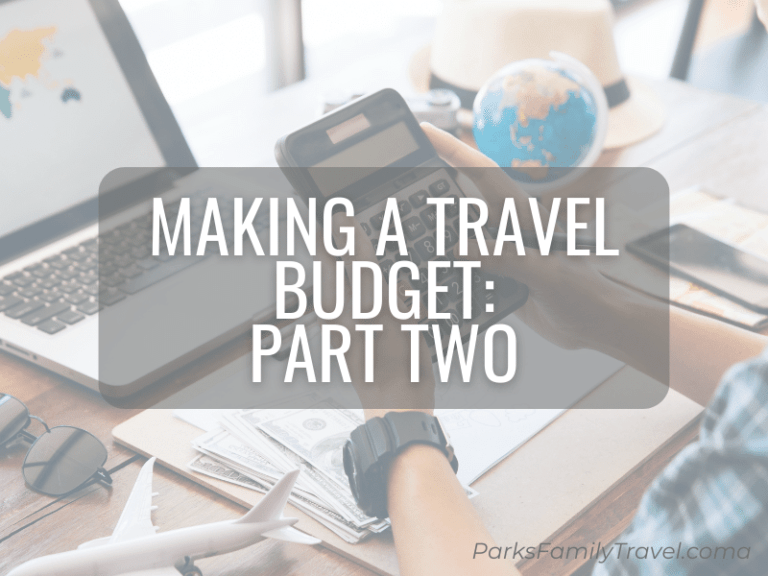Anyone who knows my family personally would easily identify us as cheap thrifty. I am always figuring out ways we can save for travel, get deals, and make those dollars stretch. I already have two other posts on budgeting for travel here: Part One and Part Two, but before we plan a travel budget, we need money for a budget. Let me share some ways you can make changes in your financial decisions to start saving for travel and to travel without the stress and burden of going into debt for a family vacation.
Disclaimer: I am not a financial professional, so please don’t take my opinions as professional advice! Just sharing my personal experience and insight. By clicking my links and making purchases, I may make a small commission with no extra cost to you. As an Amazon Associate I earn from qualifying purchases.
Embrace the Saver Mentality
My husband has taught me many things throughout our courtship and marriage. He’s taught me about love, patience, forgiveness, and to “shoot the duck” (it’s a roller skating trick FYI – and he nails it). And he’s taught me the value of saving. He’s been a saver since day one, and I have seen firsthand the benefits of saving now so you can have what you want most later. Having savings is necessary for rainy days and can significantly reduce the stress in your life. (Duh) And while being prepared for rainy days and the relief of stress reduction is important, so is finding and living your dreams. Most of us want flexibility and freedom. We want to travel and to be able to have experiences with our families. If we’re tied to our credit card or other debt, our windows of opportunity start to close. So take a second to think about which camp you currently are in, saver or spender, and then look for where you can improve your attitude and actions.
Action Item:
- Create an “I” statement or affirmation related to saving and your goals
- Example: I am in control of my spending. I know where I want my money to go.
Start Saving for Travel with a Sinking Fund
A sinking fund is a savings account designed to set aside money over time for a specific future expense or goal. Instead of scrambling to cover a large expense when it arises, you consistently contribute smaller amounts to the sinking fund. Over time, you’ve earned what you need! This works for things like rainy day funds, Christmas gift budgets, or saving for travel. If your finances are really tight it can be hard to contribute very much, but you’ve got to start somewhere. Maybe you will start at $5 from each paycheck. You can stick a five-dollar bill in a jar, or create a second savings account where you set up an automatic transfer every payday. Five bucks won’t get you very far for a while, but forward momentum is an amazing thing, and watching the savings grow will hopefully help keep motivated to keep saving and watch your spending.
Action Item:
- Create your travel sinking fund.
- Decide what you can afford to set aside each month or paycheck.
- If you’re dealing with large amounts of debt, keep this amount small, or even skip and focus on paying down your debt for now.
- Determine where the money will go each month. If it’s too tempting to have the money in your house, set up a savings account. Make sure there are no fees and try to find the best interest rate you can.
Calculate Income and Expenses
You’ve got to know what you have to work with. Whether you are living paycheck to paycheck or have a comfortable lifestyle, you need to know what’s coming in and going out. There are lots of tools to help you get everything figured out, but we were loyal Mint users, but has since been discontinued. We’re still a little sad. For now we are using Empower from Personal Capital, but the jury is still out on how I feel about it.
Once you have an idea of the cash flow in your household, you can look for patterns, or surprise expenses that add up and eat up your budget. It’s easy to dismiss a few dollars here and there, but it’s much harder once you see that you’ve spent $137 on specialty drinks, library fines, or gourmet cookies. This isn’t glamorous work. It’s boring, and a bit painful, but if you want to start saving for travel you need to start with the big picture of your finances and start making changes.
Action Item:
- Create a budget for the upcoming month.
- Start with your expected income/what you have to work with for the month.
- Move to expenses starting with rent, utilities, bills, and debt payments.
- Next are basic needs and expenses like food and gas.
- Lastly, add extras like eating out, shopping, and entertainment.
- It’s ok to just guess the first month.
- Start tracking your purchases in each category and review what you estimated and what you actually spent. Adjust next month’s budget as needed.
- Can you find places to save and increase the monthly payment for your travel sinking fund?
Write It Out
For one week, write out EVERYTHING you purchase and its cost. Not just totals from a receipt, but item by item. See any red flags? Maybe share the list with a trusted friend or family member who you think is financially savvy. Do they see any issues with what you’re buying and why? Go through the list item by item and separate them between wants and needs. From there, take a deeper look. Can you cut back anywhere? Be real with yourself, but take a long hard look at the wants list and choose one thing to reduce the next go around (Example: decrease your fast food spending by 10% next week.) Slowly making these cuts to your spending will add up over time, you will start establishing healthier financial habits, and you can start saving for travel!
Action Item:
- Set yourself up for success by creating a system for receipts.
- Find a location to store them until they are recorded.
- Create your sheet with a space for each item and its cost.
- Fill it in each day for a week.
- Review the list and decide where you can improve the next week.
Make some Money by Minimizing
We are aspiring minimalists in our home. I love the concept, yet we haven’t quite mastered the execution. But through our minimizing journey, we’ve been able to maximize our bank account. We’ve held two garage sales, sold things via online classifieds, and earned credit at a local consignment shop. Don’t get me wrong, a lot of our stuff was donated or sent straight to the garbage, but it’s quite the adrenaline rush to get cash for things that you just don’t need. It’s also a great way to help distance yourself from materialism. Realizing that things are just things, will help you in resisting future purchases you might regret later. Give it a shot. Spend a weekend cleaning out your closets, cupboards, and cars, and see how much you can get. But make sure you don’t run out and buy more things to fill the space! Put that money right into your travel savings sinking fund as an extra boost. It may seem like a drop in the bucket, but I assure you each little bit will help.
Action Item:
- Pick one room or closet to work on and get started.
- Create “Keep”, “Donate”, and “Sell” piles.
- Create at least one listing of Facebook Marketplace or a similar site.
- Make sure to add pictures and a good description.
- Be careful and wise about where to meet with potential buyers to ensure your safety.
- Put that money in your travel sinking fund as a little bonus to this month’s contribution.
Points, Miles, and the Like
There are many ways to travel hack and many accounts that will help you figure out the process. I love to follow @watchmetravelhack on Instagram because she figures out how to travel for less money with several different methods – not just credit cards. She also happens to be a de-cluttering pro and can help with minimizing for some money too! We have used credit cards a *little* bit to supplement travel, but haven’t jumped in all the way yet. Also, when you fly, stay at a hotel, or rent a car see if there are any free loyalty programs. If you are going to start traveling more regularly, member benefits can add up.
Action Item:
- Check out @watchmetravelhack and see if her methods might work for you.
- Look into your current credit card(s) and see if any travel perks or points options can help you save even more on travel.
Saving for Travel IS Possible
Money can be very tight. Rent and mortgages are increasing rapidly, inflation has hit us pretty much everywhere, and many are trying to just stay afloat. If you feel particularly discouraged financially, I urge you to take the initiative and start trying some cost-cutting measures while finding ways to increase your income. Before you plan major travel or dedicate a significant portion of your budget to it, have a plan to get out of debt and stay out of debt. There are so many resources and support groups you can find online, and seeing the success of others just might give you the motivation to make changes.
Once you are ready, get that travel sinking fund started. Pay attention to where you can cut costs, and put that money you saved in a separate account. Watch it grow, little by little, until you reach your goal. If it’s growing too slowly, re-examine where your discretionary income is going, weigh what is most important to you, and make necessary adjustments. You’ve got
Action Item Recap:
- Create an affirmation statement around saving and/or travel.
- Start a travel savings sinking fund.
- Make a one-month budget.
- Record every single item purchased for one week.
- Declutter and sell at least one item.
- Learn more about traveling with points if you are not in credit card debt.
- Start finally saving for travel and make it happen, Captain!
Have you used a sinking fund before? How do you find ways to save for travel?








